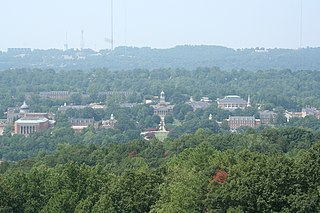
Homewood is a city in southeastern Jefferson County, Alabama, United States. It is a suburb of Birmingham, located on the other side of Red Mountain due south of the city center. The population was 26,414 at the 2020 census.

This is a list of the National Register of Historic Places listings in Morgan County, Alabama.
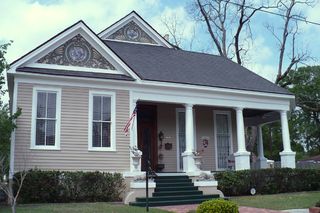
The Leinkauf Historic District is a historic district in the city of Mobile, Alabama, United States. It was placed on the National Register of Historic Places on June 24, 1987. It is roughly bounded by Government, Eslava, Lamar, and Monterey Streets. The district covers 1,100 acres (4.5 km2) and contains 303 contributing buildings. The buildings range in age from the 1820s to early 20th century and cover a variety of 19th- and 20th-century architectural styles.

The Campground Historic District, also known as The Campground is a historic district in the city of Mobile, Alabama, United States. Named for the Old Camp Ground, a military encampment that occupied the property during the American Civil War, this historically African-American neighborhood was placed on the National Register of Historic Places on July 7, 2005. It is roughly bounded by Martin Luther King Jr. Avenue, Rylands Street, St. Stephens Road, and Ann Street. The district covers 370 acres (1.5 km2) and contains 166 contributing buildings. The houses range from shotgun houses to bungalows and date from the late 19th century to the middle 20th century.

The De Tonti Square Historic District is a historic district in the city of Mobile, Alabama, United States. It was placed on the National Register of Historic Places on February 7, 1972. It is a nine-block area, roughly bounded by Adams, St. Anthony, Claiborne, and Conception Streets. The district covers 28 acres (0.11 km2) and contains 66 contributing buildings. It was named in honor of Henri de Tonti and consists mainly of townhouses built between 1840 and 1860. It includes numerous examples of the Federal, Greek Revival, and Italianate architectural styles.

The Cavallero House is a historic residence in Mobile, Alabama. It was built in 1835 in the Federal style. A cast-iron gallery was added in the mid-19th century. The house was added to the National Register of Historic Places on October 7, 1982. In addition to be individually listed in the National Register, the house is also a contributing building to the Lower Dauphin Street Historic District.

The Dahm House is a historic townhouse in Mobile, Alabama. The two-story brick structure was built in 1873 for John Dahm. It was designed by Bassett Capps. A two-story frame addition was added in 1929. The house was added to the National Register of Historic Places on January 5, 1984. In addition to being listed individually on the National Register of Historic Places, it is also a contributing building to the Lower Dauphin Street Historic District.

The Meaher–Zoghby House is a historic townhouse in Mobile, Alabama. The two-story brick structure was built in 1901 for Augustine Meaher. It retains its original cast iron details and front yard fence. The house was added to the National Register of Historic Places on January 5, 1984. In addition to being listed individually on the National Register of Historic Places, it is also a contributing building to the Lower Dauphin Street Historic District.

The Denby House is a historic raised cottage in Mobile, Alabama. The one-story brick house was built by Charles Denby in 1873. It was added to the National Register of Historic Places on January 5, 1984. In addition to being listed individually on the National Register of Historic Places, it is also a contributing building to the Lower Dauphin Street Historic District.
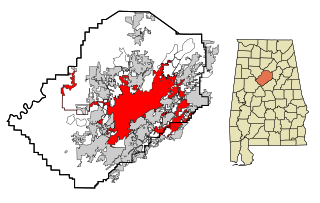
This is a list of the National Register of Historic Places listings in Birmingham, Alabama.

The Court Square–Dexter Avenue Historic District is a 17.6-acre (7.1 ha) historic district in downtown Montgomery, Alabama, United States. Centered on the Court Square Fountain, the district includes twenty-seven contributing buildings and two objects. It is roughly bounded by Dexter Avenue, Perry, Court and Monroe streets. Architectural styles in the district include Italianate, Late Victorian, and various Revival styles. It was placed on the National Register of Historic Places on March 1, 1982. The boundaries were subsequently increased on August 30, 1984.
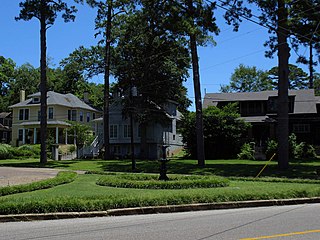
The Cloverdale Historic District is a 156-acre (63 ha) historic district in Montgomery, Alabama. It is roughly bounded by Norman Bridge and Cloverdale roads, Fairview and Felder avenues, and Boultier Street. It contains 463 contributing buildings and 4 structures that date from the mid-19th to the early 20th centuries. The district was placed on the National Register of Historic Places on September 12, 1985.

The Garden District is a 315-acre (127 ha) historic district in Montgomery, Alabama.

Barr's Subdivision Historic District is a historic district in Citronelle, Alabama, United States. It is roughly bounded by U.S. Route 45 and Howard Avenue between LeBaron Avenue and State Street. The district covers 5.9 acres (0.024 km2) and contains 7 contributing properties. It was placed on the National Register of Historic Places on July 7, 2005.
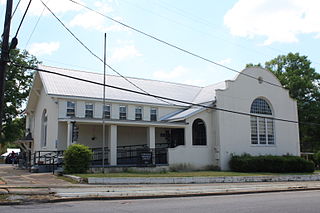
The Central Core Historic District is a historic district in Citronelle, Alabama, United States. It is roughly bounded by State Street and LeBaron Avenue from Mobile to Second streets. The district covers 69.9 acres (0.283 km2) and contains 62 contributing properties. It was placed on the National Register of Historic Places on January 25, 1990.

The Gainesville Historic District is a historic district that encompasses a historic section of Gainesville, Alabama, United States. The district was listed on the Alabama Register of Landmarks and Heritage on March 25, 1976 and the National Register of Historic Places on October 3, 1985. The district covered 76 acres (31 ha) and contained 24 historically significant contributing properties when first listed.

The West Marion Historic District is a historic district in the city of Marion, Alabama. The historic district is bounded by West Lafayette, Washington, College, Margin streets, and Murfree Avenue. It features examples of Colonial Revival, Craftsman, Greek Revival, and regional vernacular architecture. It spans 200 acres (81 ha) and contains 108 contributing properties. One contributing building of special significance is Reverie. The district was placed on the National Register of Historic Places on April 22, 1993.

Ashville Historic District is a national historic district located near Marshall, Fauquier County, Virginia. It encompasses 16 contributing buildings and 1 contributing site in the Reconstruction-era African-American rural village of Ashville. The district contains nine properties, including the Gothic Revival style Ashville Baptist Church (1899), Ashville School (1910s), Ashville Community Cemetery, and a concentration of historic dwellings and related outbuildings.
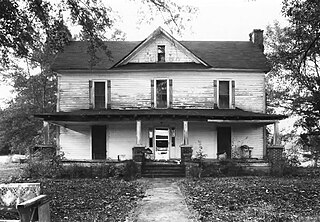
The John Ash House, also known as Rowan House, Coker House and Rickles House, is a historic residence near Ashville, Alabama. John Ash emigrated from York County, South Carolina, first to Georgia, later settling in what is today St. Clair County, Alabama in 1817. Ash became a successful farmer, and served as a judge and member of the first Alabama State Senate. In 1821 Ash was one of five local leaders appointed to oversee the construction of a county courthouse and jail; the county seat was later named Ashville in his honor. Ash built a one-story dogtrot log house around 1820. In the 1830s, the house was extensively modified: three rooms and a second story were added to the house, and the exterior was covered with frame siding. The central dogtrot was filled in, and the main portion now resembled an I-house. A triangular pedimented gable adorns the front of the house, and each side has a brick chimney. A porch was added to the front of the house in the early 1900s. The house was listed on the Alabama Register of Landmarks and Heritage in 1990 and the National Register of Historic Places in 1991.

The Dr. James J. Bothwell House, also known as Bothwell-Embry House, is a historic residence in Ashville, Alabama. The house was built in 1835 for James Bothwell, the second doctor in Ashville, and also a clerk of the circuit court. It is a two-story Federal-style house, with a two-story pedimented portico supported by four Doric columns. In 1852 a wing was added to the rear of the house for a kitchen and dining room on the ground floor and a bedroom above. Another ground floor bedroom wing was added in 1882. Another bedroom was added above in 1917, and the area between the wings was enclosed. The house was listed on the Alabama Register of Landmarks and Heritage in 1979 and the National Register of Historic Places in 1982. It is to be sold at auction in May 2014.
























